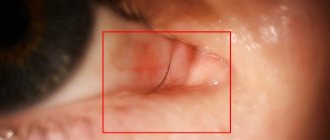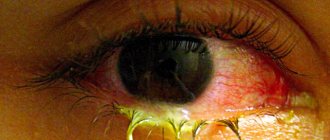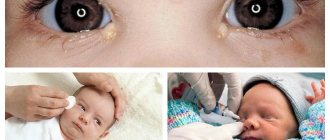After respiratory diseases, sore throat or a severe cold, the immune system weakens and the body’s defense against viruses decreases. During this period, the risk of ophthalmic inflammation, including viral conjunctivitis, increases. Viral conjunctivitis causes severe discomfort and is dangerous to health, so it is important to know its symptoms and implement prevention.
Main characteristics of viral conjunctivitis
Viral conjunctivitis is a fairly common disease. Often it occurs episodically. Conjunctivitis indicates the onset of inflammation. The process affects the mucous membrane of the eye and the inside of the eyelid.
Conjunctivitis can be a symptom of another disease. Eye inflammation is often observed with colds and systemic viral infections. Most often, conjunctivitis accompanies measles, chickenpox, rubella and mumps (mumps).
Isolated inflammation, which does not provoke systemic disorders, is usually caused by adenoviruses. Less commonly, the cause is the activity of enteroviruses. The incubation period of the disease is 5-12 days. After this, the eye turns red, discharge occurs, and irritation of the mucous membrane is felt. Inflammation quickly spreads to the second eye.
In severe cases, patients report a sensation of foreign particles in the eye. Photophobia often develops. Vision loses clarity due to the formation of fibrin pseudomembranes and inflammatory cells. After severe conjunctivitis, foci of corneal opacification can be noticed during examination for the next 2 years.
In children, viral conjunctivitis develops due to poor hygiene in situations where the child picks up dirty objects and immediately rubs his eyes. It is noteworthy that in children, viral conjunctivitis is milder. Therefore, severe cases of inflammation in children are much less common, and mild conjunctivitis often does not even require treatment.
What is eye conjunctivitis in children: types, causes
Conjunctivitis is a fairly common disease, especially among children. This is nothing more than inflammation of the mucous membrane of the eye. The disease is characterized by redness of the eyeball and tearing. In this case, the eyelids may swell and itch constantly. The disease is caused by bacteria or viruses. Accordingly, depending on the pathogen, the treatment for diseases is different.
Types of conjunctivitis:
- Bacterial
- Chronic
- Adenoviral
- Purulent
- Allergic
Causes of conjunctivitis:
- Bacterial damage
- Effect of the virus
- Allergic reaction
- Contact with foreign bodies
- Ultraviolet radiation
What is eye conjunctivitis in children: types, causes
Types of viral conjunctivitis
The inflammation affects both eyes, although usually only one is affected at first. A distinctive feature of viral conjunctivitis is its frequency during the months of the spread of adenoviral and enteroviral diseases.
Herpetic conjunctivitis
Damage to the mucous membranes and conjunctivitis develop when the herpes virus actively multiplies in a weakened body. Typically, inflammation appears due to the herpes virus or herpes zoster; less commonly, the Epstein-Barr virus and cytomegalovirus are the cause. The cause of herpetic conjunctivitis is infection with the herpes virus, usually at an early age.
A characteristic sign of such inflammation is severe damage to the edges of the eyelid, skin and cornea. The course can be vesicular-ulcerative or follicular, but most often the inflammation is superficial.
Herpetic conjunctivitis begins in one eye. At first, the inflammation is sluggish and slow, and the symptoms are usually erased. Conjunctivitis can be combined with rashes on the skin of the eyelids and around the eyes. The catarrhal form is characterized by the presence of slight mucous discharge. If a bacterial infection begins in parallel, purulent discharge appears.
Herpetic conjunctivitis requires specific treatment, which cannot be delayed. Self-medication increases the chances of worsening inflammation. Often after herpetic conjunctivitis, dendritic keratitis develops with damage to the cornea.
Adenoviral conjunctivitis
Adenoviral conjunctivitis usually affects the eyes and nasopharynx. The patient has catarrh of the upper respiratory tract, high fever, and swollen lymph nodes. There is marked redness of the eyes and eyelids, as well as significant swelling. Adenoviral conjunctivitis rarely affects the cornea.
Viral conjunctivitis can be diagnosed based on laboratory, cytological, serological and virological studies. Such inflammation is usually diagnosed in children. Adenoviruses are transmitted by airborne droplets, so this conjunctivitis is contagious. Sometimes infection occurs through contact.
Classification
Ocular viral conjunctivitis comes in different types. Each form has its own characteristics.
Adenoviral
This type of disease can occur in a child of any age, except for babies in the first year of life who are breastfed. Mother's milk contains special antibodies that prevent the infection from developing. This form of conjunctivitis is provoked by adenoviruses types 3, 4, 7. They can enter the body through conversation, touching an infected person or his belongings. Adenoviral conjunctivitis is divided into 3 subtypes: catarrhal, membranous, follicular.
Rice. 2. According to statistics, viral conjunctivitis is most often caused by adenoviruses.
Catarrhal
Mostly occurs against the background of respiratory diseases.
Filmy
The incubation period lasts longer than in other cases, approximately 5-8 days. First, the child gets a sore throat, then the damage spreads to the eyes.
Follicular
When infected, pathological changes occur in tissues and lymph nodes.
Herpetic
The causative agent of this form of the disease is the herpes simplex virus (HSV). Most often, children who do not observe personal hygiene rules and use other people's household items become infected. The infection can also spread through airborne droplets.
Epidemic
Most often, infection occurs in countries with hot climates. However, you can become infected in our country in the summer. The causative agent is the Koch-Wicks bacillus. The pathogen enters the eyes through dirty hands or household items touched by an infected person. In addition, infectious agents are carried on the legs of flies.
Even after treatment, pathogens remain in the body. When the immune system is weakened, they begin their life activities. It is very easy to become infected with this type of viral conjunctivitis; it often becomes the cause of an epidemic.
Against the background of chickenpox
This form of the disease accompanies chickenpox, the causative agent of which is herpes type 3.
Contagious
It is provoked by molluscum contagiosum. Can be spread by contact or through water, such as swimming in a pool. The risk of infection increases if there is damage to the skin (scratches, abrasions, etc.). If this form of viral conjunctivitis is not cured within 1-2 weeks, the cornea begins to become cloudy, and partial loss of vision is possible.
Hemorrhagic
This form can trigger the onset of an epidemic, because is highly contagious. The causative agents are picornaviruses.
How is viral conjunctivitis transmitted?
According to the nature of the pathogen, inflammation is divided into isolated and concomitant. Isolated conjunctivitis is caused by the activity of a specific virus. This could be herpes, enterovirus, adenovirus, Coxsackie virus and others. Concomitant inflammation develops against the background of another viral infection (measles, chickenpox, rubella, mumps, influenza).
In 70% of cases, patients with viral conjunctivitis require hospitalization. This is due to the fact that the disease is easily transmitted to others: viruses are transmitted less frequently by airborne droplets than by contact, but herpetic conjunctivitis spreads primarily through the air.
Causes
Viral conjunctivitis of the eyes is provoked mainly by the same agents that cause other viral diseases:
- enteroviruses;
- adenoviruses types 3, 4 and 7;
- pathogens of common and herpes zoster;
- infectious agents that cause chickenpox and measles.
When they get on the mucous membrane of the organs of vision, the inflammatory process begins. Moreover, they can penetrate there not only directly, but also through the respiratory system.
As mentioned earlier, the infection is transmitted:
- By contact. For example, when a child touches the eyes of an infected person and then rubs his own. Or uses the objects of the infected.
- By airborne droplets. That is, for infection it is not necessary to touch your face with dirty hands. It is enough to stay close to an infected person for some time.
Expert opinion
Ermolaeva Tatyana Borisovna
Ophthalmologist of the highest category, Candidate of Medical Sciences
Note! Conjunctivitis of viral origin is not necessarily transmitted from child to another. Adults can also be carriers and infected from a baby.
A predisposing factor to the disease in newborns up to six months old can be blockage of the lacrimal canal. As a result, when dust, dirt, etc. gets in, they are not washed off during lacrimation, but penetrate into the mucous membrane. In older children, the infection can enter the organs of vision along with foreign objects, incl. with sand and other debris. The risk of infection increases when the body is weakened, for example, after a long illness or during its exacerbation.
Clinical picture of viral conjunctivitis
At the initial stage of development, any type of inflammation is manifested by redness of the mucous membrane, swelling of the eyelids, and lacrimation. Conjunctivitis is characterized by first damage to one eye, then rapid spread of the process to the second. Sometimes, with viral conjunctivitis, severe headaches occur, and patients begin to experience fatigue and weakness. There are sleep disturbances and enlarged lymph nodes.
Symptoms of different forms of inflammation:
- With the catarrhal form of conjunctivitis, profuse lacrimation is noted. Minor purulent discharge may appear. Viral conjunctivitis lasts an average of a week.
- Follicular inflammation is characterized by the appearance of follicles on the edges of the eyelid.
- The intensification of conjunctivitis and the transition to a vesicular-ulcerative form will be indicated by the appearance of ulcers and erosions. This form is often accompanied by lacrimation, photophobia, discomfort and even pain.
- The membranous form of conjunctivitis causes the appearance of a thin grayish film that can be easily removed with a cotton swab. In some cases, the film cannot be removed. This inflammation is characterized by the appearance of hemorrhages and small compactions.
After a week, patients begin to feel relief, but the symptoms of inflammation intensify again. Viral conjunctivitis can last 2 months, but with timely treatment it can be cured much faster.
Diagnostics
The symptoms of viral conjunctivitis are similar to many other diseases of the organs of vision. Therefore, you cannot make a diagnosis yourself. This can only be done by a pediatrician together with an ophthalmologist.
Diagnostics include:
- collecting anamnesis of the pathological condition;
- visual examination by an ophthalmologist, incl. with side light, as well as using special equipment;
- taking a smear to identify the pathogen (cytological, serological and bacteriological examination).
Expert opinion
Ermolaeva Tatyana Borisovna
Ophthalmologist of the highest category, Candidate of Medical Sciences
Note! Sometimes it may be necessary to consult doctors of related specialties, such as an allergist and others.
Treatment of viral conjunctivitis
The first step for conjunctivitis is to prescribe tear substitutes for normal hydration of the mucous membrane and warm compresses. For severe inflammation, your ophthalmologist may prescribe corticosteroid eye drops. Hormones help balance secretions, but they must be used carefully and in short courses. Ointments and drops with antiviral effects help cure viral conjunctivitis.
During pregnancy, you should carefully select medications for the treatment of viral conjunctivitis. Inflammation does not harm the fetus, but some medications can be dangerous (chloramphenicol). For conjunctivitis in pregnant and lactating women, Actipol or Poludan are prescribed.
For any type of conjunctivitis, Albucid drops with sodium sulfacyl will be effective. The drug is instilled after washing, then drops with interferon are used and after 30 minutes the ointment is applied.
Viral conjunctivitis is treated with antiviral drops
- Oftalmoferon. The drug has antiviral, anti-inflammatory and immunomodulatory effects. This effect is caused by the presence of human interferon in the composition of Ophthalmoferon. The product must be instilled 6-8 times a day during an acute process and 2-3 times during recovery.
- Poludan. These antiviral drops are based on biosynthetic endogenous interferons, cytokines and interferons in the tear fluid. Poludan is prescribed for adenoviral and herpetic conjunctivitis. The product is instilled 6-8 times a day and 3-4 times as recovery progresses. The course of treatment is from 7 to 10 days.
- Aktipol. The drug is an inducer of endogenous interferon, which has antiviral, regenerative and antioxidant effects on tissues and mucous membranes. Actipol is instilled 3-8 times a day (2 drops). The course of treatment for conjunctivitis is 10 days.
In addition to drops, the ophthalmologist may prescribe additional antiviral ointments. Some drugs are approved for children, but before use it is advisable to rinse the eyes with a fresh infusion of chamomile, sage or weak tea. You should first check for allergies to these drugs.
What ointments can be used for viral conjunctivitis
- Florenal. An antiviral agent that effectively fights the herpes virus, adenoviruses, varicella zoster virus (herpes zoster and chickenpox). The ointment should be used 2-3 times a day. Florenal is placed behind the lower eyelid. The course of treatment for conjunctivitis is 10-45 days.
- Tebrofenovaya. This is a universal remedy that is prescribed for any viral lesions of the visual system. The ointment is most effective for adenoviral conjunctivitis. It is necessary to use it 3-4 times a day.
- Bonafton. The drug is active against adenoviruses and herpes viruses. Adults should use the ointment 3-4 times a day, 0.1 g for 15-20 days. Children with conjunctivitis are prescribed 1-4 doses of 0.025 g for two weeks.
Sometimes, for viral conjunctivitis, antibacterial ointments with antibiotics are prescribed. If an infection is associated with inflammation, it is necessary to add erythromycin or tetracycline ointments to the therapy. Adenoviral conjunctivitis with proper treatment disappears in 2-3 weeks.
Therapy for herpetic conjunctivitis includes antiviral, anti-inflammatory, interferon drops and ointments. If the skin of the eyelids is severely damaged, it should be carefully treated with brilliant green.
Therapy for herpetic inflammation
- Applying antiherpetic ointment (Zovirax, Acyclovir, Virolex, Bonafton, Florenal, tebrofen ointment).
- If the skin around the eyes is affected, oral antiherpetic drugs (Acyclovir, Valtrex) are prescribed.
- Additionally, immunomodulators (Cycloferon or Polyoxidonium) are required.
- To prevent bacterial infection, antibiotic eye ointments (erythromycin, tetracycline) or drops (Tobrex) are prescribed.
If a bacterial infection has begun, you need to add antimicrobial drugs to the antiviral drugs. This may be Levomycetin, but it cannot be used for fungal skin infections, psoriasis, eczema, as well as for pregnant and lactating women. Furacilin also has an antimicrobial effect, but also accelerates tissue regeneration. For conjunctivitis, it is prescribed for washing or instillation. A solution can be prepared by mixing furatsilin with sodium chloride (1:5000).
How long does it take to treat conjunctivitis in children?
Regular conjunctivitis caused by an adenovirus is treated in about 7-10 days. With proper treatment, symptoms disappear after a few days. Gonococcal or chlamydial conjunctivitis in newborns is treated for 2-3 months.
How long does it take to treat conjunctivitis in children?
How to treat acute conjunctivitis
With acute inflammation, a lot of purulent discharge appears that needs to be removed, otherwise the risk of developing a microbial environment increases. For cleaning, use boron solution or antibacterial drops.
Acute forms of conjunctivitis are treated with viruscidal drugs with oxoline, tebrofen or florenal. These can be ointments or solutions. The use of Albucid and tetracycline ointment for acute conjunctivitis is ineffective, but these drugs are suitable for preventing relapse.
Alternative treatment for viral conjunctivitis
Traditional medicine recipes can only be used in complex therapy of viral conjunctivitis. You can use any means for eye inflammation only with the permission of an ophthalmologist, otherwise you can aggravate the condition and provoke serious complications.
The most effective method of treating eye inflammation is lotions. It is allowed to apply gauze or cotton cloth soaked in dill juice. 15 minutes at a time is enough.
For inflammation, you can use rosehip infusion. To prepare it, you need to infuse two tablespoons of berries in a glass of boiling water, filter and apply to your eyes for 15 minutes.
Honey is sometimes used to prepare lotions. You need to add a teaspoon to a glass of water and boil for 2 minutes. After the solution has cooled, a suitable cloth is moistened in it and applied to the eyes for 15 minutes twice a day. It should be remembered that honey often causes a severe allergic reaction.
Herbs can help fight inflammation. To prepare a solution for lotions, you need to boil two tablespoons of cornflower flowers in 0.5 liters of water (10 minutes). Leave to infuse for 30 minutes, strain and use similarly to other lotions.
Chamomile and sage are suitable for washing with viral conjunctivitis. You can make compresses against inflammation using aloe juice: mix the juice and cooled boiled water (1:1). Compresses can be done 2-3 times a day and kept for 5-10 minutes.
What folk remedies are used to treat conjunctivitis in children?
Many mothers do not want to stuff their children with chemicals, so they prefer folk remedies. They mainly involve the use of herbs and decoctions.
- Chamomile. A weak decoction of chamomile can not only be used to put drops in your eyes, but also to clean them.
- Chopped bay leaf. It is necessary to pour 200 ml of boiling water over the leaf, leave and strain. Use the resulting infusion to wipe your eyes 5-6 times a day.
- Aloe juice. It is necessary to prepare a solution. To do this, 2 aloe leaves are peeled and turned into puree. This puree is diluted with water in a 1:1 ratio.
What folk remedies are used to treat conjunctivitis in children?
Complications of viral conjunctivitis
The most common complication of conjunctivitis is the transition of the disease to a chronic form. This occurs with insufficient or incorrect treatment. Non-compliance with doctor’s recommendations, violation of medication regimen, and termination of therapy before complete recovery can contribute to the chronicity of inflammation.
Also often with conjunctivitis, keratitis develops, that is, inflammation of the cornea. This condition can cause blindness, so treatment of the inflammation must be taken seriously. When deep tissues are damaged, dangerous phlegmons and abscesses form.
Prevention of eye inflammation
The main measure to prevent viral conjunctivitis is to avoid contact with sick people and potentially contaminated objects (for example, in a hospital). During the period of active spread of viral infections, crowds of people should be avoided and the immune system should be strengthened in every possible way.
To protect yourself from viral conjunctivitis, you must follow the rules of personal hygiene. You should wash your hands regularly using disinfectants and special wipes. You need to dry your hands and face with a personal towel.
A healthy lifestyle and taking vitamins will help strengthen the body and counteract viruses. We must not forget about preventive examinations, because an ophthalmologist can notice early symptoms of inflammation. By taking precautions and leading a healthy lifestyle, you can protect yourself from viral conjunctivitis and protect your loved ones.
Sources used:
- Current issues in ophthalmology / ed. T.V. Shlopak, Ustimenko Ustimenko I L.L. etc. I. - M.: Kyiv, 1986.
- Eye microsurgery. Guide for doctors / A.I. Gorban, O.A. Jaliashvili. - M.: Medicine, 1982.
- Revelations of a surgeon. How I did the world's first eye transplant / E. Muldashev. - Moscow: Lights, 2010.
- Wikipedia article
How to prevent your child from getting conjunctivitis: prevention of conjunctivitis in children
Prevention measures:
- Use personal hygiene products
- Wash your hands after going outside
- During epidemics, strengthen your baby’s immunity with vitamins
- Get your vaccinations on time
- Don't let your baby touch his eyes with dirty hands.
- Limit communication between a healthy child and a sick child
- If you have allergies, try to exclude your baby from contact with allergens.
- Be sure to plan your pregnancy so that your child does not become infected with gonococcal or chlamydial conjunctivitis
How to prevent your child from getting conjunctivitis: prevention of conjunctivitis in children











